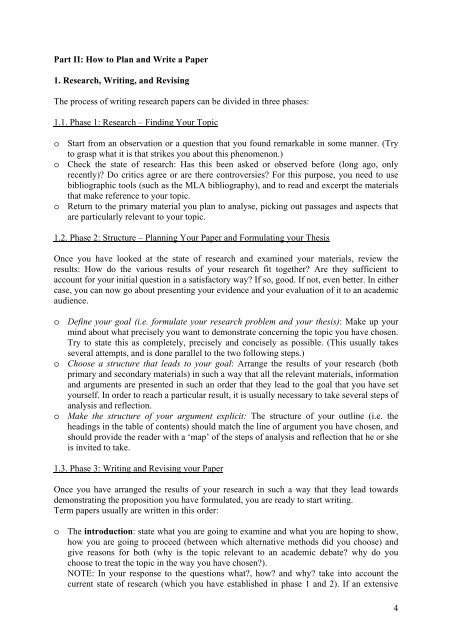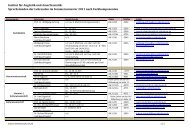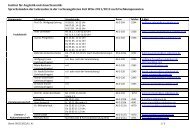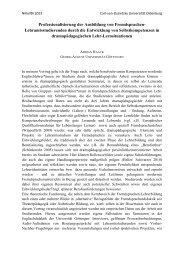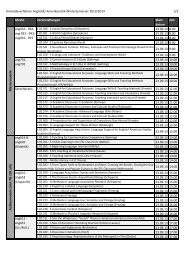1 Guidelines and Style Sheet for Writing Research Papers in Literary ...
1 Guidelines and Style Sheet for Writing Research Papers in Literary ...
1 Guidelines and Style Sheet for Writing Research Papers in Literary ...
You also want an ePaper? Increase the reach of your titles
YUMPU automatically turns print PDFs into web optimized ePapers that Google loves.
Part II: How to Plan <strong>and</strong> Write a Paper<br />
1. <strong>Research</strong>, <strong>Writ<strong>in</strong>g</strong>, <strong>and</strong> Revis<strong>in</strong>g<br />
The process of writ<strong>in</strong>g research papers can be divided <strong>in</strong> three phases:<br />
1.1. Phase 1: <strong>Research</strong> – F<strong>in</strong>d<strong>in</strong>g Your Topic<br />
o Start from an observation or a question that you found remarkable <strong>in</strong> some manner. (Try<br />
to grasp what it is that strikes you about this phenomenon.)<br />
o Check the state of research: Has this been asked or observed be<strong>for</strong>e (long ago, only<br />
recently)? Do critics agree or are there controversies? For this purpose, you need to use<br />
bibliographic tools (such as the MLA bibliography), <strong>and</strong> to read <strong>and</strong> excerpt the materials<br />
that make reference to your topic.<br />
o Return to the primary material you plan to analyse, pick<strong>in</strong>g out passages <strong>and</strong> aspects that<br />
are particularly relevant to your topic.<br />
1.2. Phase 2: Structure – Plann<strong>in</strong>g Your Paper <strong>and</strong> Formulat<strong>in</strong>g your Thesis<br />
Once you have looked at the state of research <strong>and</strong> exam<strong>in</strong>ed your materials, review the<br />
results: How do the various results of your research fit together? Are they sufficient to<br />
account <strong>for</strong> your <strong>in</strong>itial question <strong>in</strong> a satisfactory way? If so, good. If not, even better. In either<br />
case, you can now go about present<strong>in</strong>g your evidence <strong>and</strong> your evaluation of it to an academic<br />
audience.<br />
o Def<strong>in</strong>e your goal (i.e. <strong>for</strong>mulate your research problem <strong>and</strong> your thesis): Make up your<br />
m<strong>in</strong>d about what precisely you want to demonstrate concern<strong>in</strong>g the topic you have chosen.<br />
Try to state this as completely, precisely <strong>and</strong> concisely as possible. (This usually takes<br />
several attempts, <strong>and</strong> is done parallel to the two follow<strong>in</strong>g steps.)<br />
o Choose a structure that leads to your goal: Arrange the results of your research (both<br />
primary <strong>and</strong> secondary materials) <strong>in</strong> such a way that all the relevant materials, <strong>in</strong><strong>for</strong>mation<br />
<strong>and</strong> arguments are presented <strong>in</strong> such an order that they lead to the goal that you have set<br />
yourself. In order to reach a particular result, it is usually necessary to take several steps of<br />
analysis <strong>and</strong> reflection.<br />
o Make the structure of your argument explicit: The structure of your outl<strong>in</strong>e (i.e. the<br />
head<strong>in</strong>gs <strong>in</strong> the table of contents) should match the l<strong>in</strong>e of argument you have chosen, <strong>and</strong><br />
should provide the reader with a ‘map’ of the steps of analysis <strong>and</strong> reflection that he or she<br />
is <strong>in</strong>vited to take.<br />
1.3. Phase 3: <strong>Writ<strong>in</strong>g</strong> <strong>and</strong> Revis<strong>in</strong>g your Paper<br />
Once you have arranged the results of your research <strong>in</strong> such a way that they lead towards<br />
demonstrat<strong>in</strong>g the proposition you have <strong>for</strong>mulated, you are ready to start writ<strong>in</strong>g.<br />
Term papers usually are written <strong>in</strong> this order:<br />
o The <strong>in</strong>troduction: state what you are go<strong>in</strong>g to exam<strong>in</strong>e <strong>and</strong> what you are hop<strong>in</strong>g to show,<br />
how you are go<strong>in</strong>g to proceed (between which alternative methods did you choose) <strong>and</strong><br />
give reasons <strong>for</strong> both (why is the topic relevant to an academic debate? why do you<br />
choose to treat the topic <strong>in</strong> the way you have chosen?).<br />
NOTE: In your response to the questions what?, how? <strong>and</strong> why? take <strong>in</strong>to account the<br />
current state of research (which you have established <strong>in</strong> phase 1 <strong>and</strong> 2). If an extensive<br />
4


